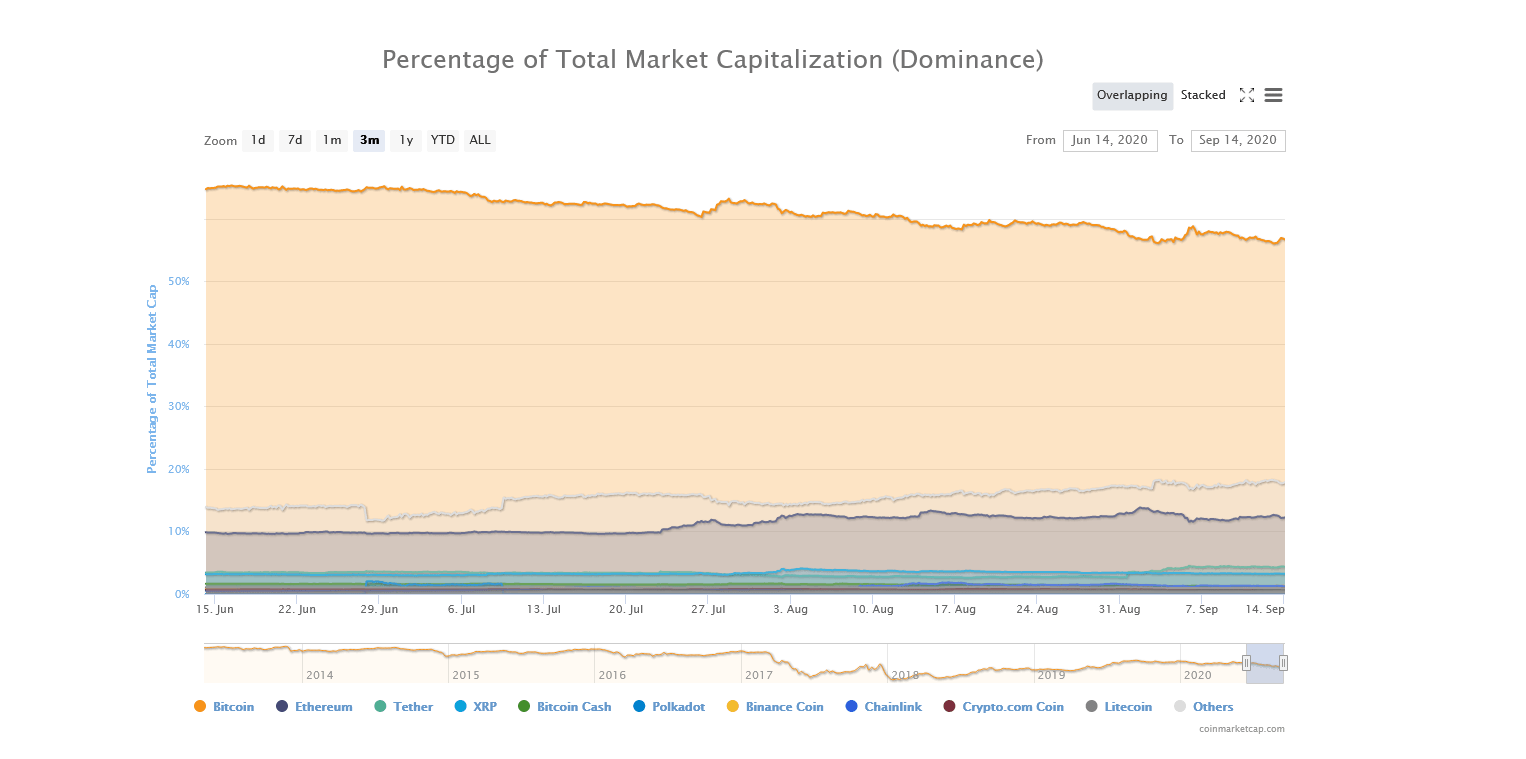Bitcoin might be the grandfather of cryptocurrency but since its inception, countless altcoins have sprung up with the aim of solving problems that Bitcoin doesn’t.

Image via Pixabay
Bitcoin is easily the best-known cryptocurrency, representing more than 55% of the total crypto market. Bitcoin is also the most popular choice for institutional investors as well as consumers speculating in the markets.
But what makes up the remaining 45%? There are thousands of other cryptocurrencies, collectively known as altcoins.
These coins are an important part of the cryptocurrency ecosystem and come in a huge variety, making them an interesting, if complicated, prospect for traders and investors.
Free Reports:
 Get our Weekly Commitment of Traders Reports - See where the biggest traders (Hedge Funds and Commercial Hedgers) are positioned in the futures markets on a weekly basis.
Get our Weekly Commitment of Traders Reports - See where the biggest traders (Hedge Funds and Commercial Hedgers) are positioned in the futures markets on a weekly basis.
 Sign Up for Our Stock Market Newsletter – Get updated on News, Charts & Rankings of Public Companies when you join our Stocks Newsletter
Sign Up for Our Stock Market Newsletter – Get updated on News, Charts & Rankings of Public Companies when you join our Stocks Newsletter
What Exactly Is an Altcoin?
An altcoin is essentially any cryptocurrency that isn’t Bitcoin. These coins represent a variety of projects — each with different goals, characteristics, and value.
Altcoins can be broken into four main categories:
- Mining-based coins:Created through Proof of Work (PoW) mining processes similar to Bitcoin. They use this process to unlock blocks and secure their blockchains. Well-known coins like Litecoin and Ethereum use this consensus method. But with version 2.0, Ethereum is seeking to move to Proof of Stake (PoS)
- Stablecoins: Designed to provide a solution for Bitcoin’s volatility. This is typically achieved by tying the value of the coin to existing currencies or commodities. Well-known examples include Tether, which is tied to the US dollar.
- Security Tokens:Tied to a business, these are roughly analogous to traditional stocks. These are typically issued during initial coin offerings (ICOs) and are considered high risk, even by cryptocurrency standards.
- Utility Tokens:Designed to fulfill a specific purpose or provide a service. They are also sometimes sold as part of an ICO. A well-known example of a utility token is Ethereum’s ERC20 token.
Most altcoins are designed to solve Bitcoin’s perceived shortcomings. The largest areas of concern surrounding Bitcoin are scalability and utility.
Bitcoin transactions all take place using PoW, which is computationally expensive. This can send transaction fees through the roof during periods of high usage.
Additionally, Bitcoin is only capable of processing 4.6 transactions per second, compared to Visa’s 1,700. This severely limits its utility as a currency and essentially relegates BTC to a store of value.
Altcoins vs Bitcoin
Altcoins are not inherently better or worse than Bitcoin. But they often come with features Bitcoin lacks or have advantages over BTC in terms of utility.
Covering the thousands of altcoins in existence would be impossible. So we’ll consider some of the more popular coins and explain why they are relevant in the crypto marketplace.
Ethereum — Bringing Smart Contracts to the Blockchain
Ethereum is the second-largest cryptocurrency and the premier alternative to Bitcoin. What makes Ethereum special is the Ethereum network and ERC20. This makes it possible for other projects to build themselves on Ethereum using smart contracts.
These contracts use the principle of “code is law” to specify particular outcomes assuming all criteria are met. For example, they could be used as a more affordable alternative to an escrow account during a property sale.

Chart via coinmarketcap.com
Most recently, Ethereum has received a huge boost thanks to the Decentralized Finance (DeFi) craze. The cryptocurrency has been quietly catching up on Bitcoin as many DeFi apps have used ERC20 as their foundation.
Investors are also excited by Ethereum 2.0 and the much-anticipated shift to PoS consensus, which could help resolve many of the scalability issues currently experienced by the currency.
Tether — Stabilizing Cryptocurrency
Tether is by far the most well-known example of a stablecoin and is the third-largest crypto by market capitalization. It has one of the highest usage rates of any cryptocurrency and it is estimated that around 80% of all crypto trading in the world happens through the Tether stablecoin.
Unlike Bitcoin or Ethereum, Tether is pegged to the US dollar (USD). This is useful because it allows investors to quickly trade between Bitcoin and USD without having to actually liquidate their cryptocurrency into fiat, which is typically expensive. In fact, if you have USD in a crypto exchange, it’s probably being kept as Tether tokens.
Despite its importance to the crypto ecosystem, Tether is facing legal troubles. The New York Attorney General has recently called on Tether to provide overdue financial documents for an ongoing case. The documents relate to allegations that Bitfinex hid around $1 billion in customer losses using Tether reserves. Tether is fighting the request but it could lead to trouble for the cryptocurrency in the near future.
Ripple — Making Payments Easier
While one could argue that Bitcoin is a philosophical endeavor, Ripple was founded by big business, for big business. The primary aim of Ripple is to create a system of direct asset transfers in real-time that are cheaper, more transparent, and secure than existing payment methods such as SWIFT.
The key difference between Ripple and Bitcoin is that Ripple does not rely on miners to secure its blockchain. Instead, the Ripple Network is managed by a range of independent servers that compare transaction records constantly. This enables the cryptocurrency to process a transaction in just five seconds.
In essence, Ripple solves the usability problem for cryptocurrency. It is possible to trade fiat directly for Ripple without involving a third-party exchange. This means that a Ripple transaction costs as little as 0.04¢ and is less volatile than using Bitcoin, making Ripple far more practical in the short term.
 Experiments with Altcoins – Create your altcoin
Experiments with Altcoins – Create your altcoin
Altcoin Experiments Help Improve Cryptocurrency
Just like in the business world, new altcoin projects can help improve on existing cryptocurrency technologies. Projects like Ripple and Ethereum have already redefined cryptocurrency and there are countless other projects that promise to do the same.
That being said, just like startups, altcoins are inherently unstable and there’s no guarantee a project will come to fruition. If you want to invest in an altcoin, do your research, and don’t invest any money you can’t afford to lose.
By Taylor Wilman

- Goldman Sachs has updated its economic projections for 2025. EU countries are looking for alternative sources of natural gas Dec 23, 2024
- COT Bonds Charts: Speculator Bets led by SOFR 3-Months & 10-Year Bonds Dec 21, 2024
- COT Metals Charts: Speculator Bets led lower by Gold, Copper & Palladium Dec 21, 2024
- COT Soft Commodities Charts: Speculator Bets led by Live Cattle, Lean Hogs & Coffee Dec 21, 2024
- COT Stock Market Charts: Speculator Bets led by S&P500 & Russell-2000 Dec 21, 2024
- Riksbank and Banxico cut interest rates by 0.25%. BoE, Norges Bank, and PBoC left rates unchanged Dec 20, 2024
- Brent Oil Under Pressure Again: USD and China in Focus Dec 20, 2024
- Market round-up: BoE & BoJ hold, Fed delivers ‘hawkish’ cut Dec 19, 2024
- NZD/USD at a New Low: The Problem is the US Dollar and Local GDP Dec 19, 2024
- The Dow Jones has fallen for 9 consecutive trading sessions. Inflationary pressures are easing in Canada. Dec 18, 2024
